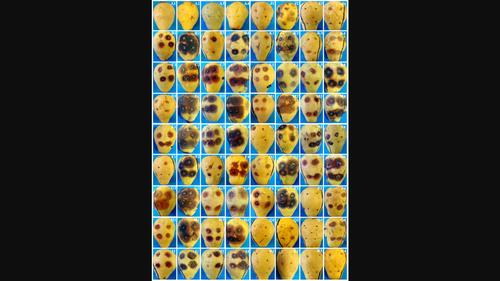Diversity of Colletotrichum causing anthracnose on Psidium guajava in varied Brazilian physiographic regions
IF 2.4
3区 农林科学
Q1 AGRONOMY
引用次数: 0
Abstract
Anthracnose, caused by several Colletotrichum species, is a major restricting factor for guava production, but no comprehensive study of the causal agent has been conducted from the plant host centre of diversity. This work characterizes isolates from guava, mainly from the fruit, but also leaves and flowers, representing most Brazilian physiographies according to the partial sequences of the rDNA-ITS, ApMAT, TUB2, HIS3 and GAPDH gene regions. In addition, the pathogenicity and aggressiveness to fruits of two widely planted guava varieties (SLG and RM) are described. Guava-derived Colletotrichum isolates were found in five complexes: gloeosporioides, acutatum, boninense, gigasporum and orchidearum. The gloeosporioides complex was the most prevalent (81%), followed by the acutatum complex (14%). A total of 16 Colletotrichum species were naturally associated with guava anthracnose: C. aeschynomenes, C. asianum, C. chrysophilum, C. fructicola, C. gigasporum, C. gloeosporioides, C. karsti, C. melonis, C. musae, C. nymphaeae, C. paranaense, C. siamense, C. sojae, C. syzygicola, C. theobromicola and C. tropicale. Apart from C. nymphaeae and C. gloeosporioides, all the remaining 14 taxa are reported for the first time in P. guajava. The most aggressive species belonged to the C. gloeosporioides complex. C. siamense was the most prevalent, especially in warmer regions, followed by C. chrysophilum, mostly in temperate environments. The most aggressive species were C. siamense, C. chrysophilum, C. fructicola and C. tropicale. Fruits of the variety SLG were consistently more resistant to anthracnose than the fruits of RM.

巴西不同地貌区引起番石榴炭疽病的 Colletotrichum 的多样性
由多种 Colletotrichum 引起的炭疽病是番石榴生产的主要限制因素,但尚未从植物寄主的多样性中心对病原进行过全面研究。这项工作根据 rDNA-ITS、ApMAT、TUB2、HIS3 和 GAPDH 基因区的部分序列,描述了从番石榴中分离出的病原菌的特征,这些病原菌主要来自果实,也有叶片和花朵,代表了巴西大部分的生理特征。此外,还介绍了两种广泛种植的番石榴品种(SLG 和 RM)的致病性和对果实的侵袭性。在五个复合体中发现了来自番石榴的 Colletotrichum 分离物:gloeosporioides、acutatum、boninense、gigasporum 和 orchidearum。最常见的是钩孢属复合体(81%),其次是尖孢属复合体(14%)。与番石榴炭疽病自然相关的 Colletotrichum 种类共有 16 种:C. aeschynomenes、C. asianum、C. chrysophilum、C. fructicola、C. gigasporum、C. gloeosporioides、C. karsti、C. melonis、C. musae、C. nymphaeae、C. paranaense、C. siamense、C. sojae、C. syzygicola、C. theobromicola 和 C. tropicale。除了 C. nymphaeae 和 C. gloeosporioides 外,其余 14 个分类群都是首次在番石榴中发现。最具攻击性的物种属于 C. gloeosporioides 复合体。C. siamense最为普遍,尤其是在温暖地区,其次是 C. chrysophilum,主要在温带环境中。最具侵袭性的种类是 C. siamense、C. chrysophilum、C. fructicola 和 C. tropicale。品种 SLG 的果实对炭疽病的抗性一直高于 RM 的果实。
本文章由计算机程序翻译,如有差异,请以英文原文为准。
求助全文
约1分钟内获得全文
求助全文
来源期刊

Plant Pathology
生物-农艺学
CiteScore
5.60
自引率
7.40%
发文量
147
审稿时长
3 months
期刊介绍:
This international journal, owned and edited by the British Society for Plant Pathology, covers all aspects of plant pathology and reaches subscribers in 80 countries. Top quality original research papers and critical reviews from around the world cover: diseases of temperate and tropical plants caused by fungi, bacteria, viruses, phytoplasmas and nematodes; physiological, biochemical, molecular, ecological, genetic and economic aspects of plant pathology; disease epidemiology and modelling; disease appraisal and crop loss assessment; and plant disease control and disease-related crop management.
 求助内容:
求助内容: 应助结果提醒方式:
应助结果提醒方式:


